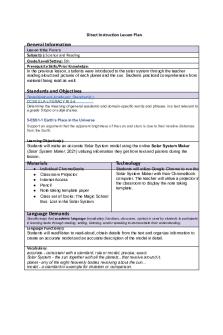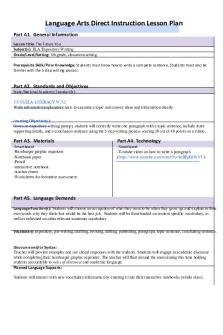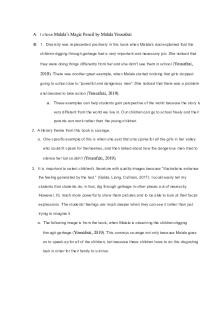Task 1 - Lesson Plan PDF

| Title | Task 1 - Lesson Plan |
|---|---|
| Course | Preclinical Experiences in Elementary Education |
| Institution | Western Governors University |
| Pages | 6 |
| File Size | 107.4 KB |
| File Type | |
| Total Downloads | 81 |
| Total Views | 199 |
Summary
Lesson Plan...
Description
Describe three classroom management strategies you observed or participated in during your live classroom experience. A. Interactive Modeling: For each activity we did in Mrs. Nunnikhoven’s kindergarten class, she used interactive modeling. I asked Mrs. Nunnikhoven after a couple hours of observing her, on why she uses this strategy. She stated she found this most effective with the variety of types of learners she had in her class. Mrs. Nunnikhoven would explain the activity and why it is important, model the activity whether it by literacy, math, reading, etc. She would them ask students what they noticed about what she did. She would often call on a student to repeats a portion of what she did, and then she would have all students go back to their table groups and work as she out loud talked about the activity. We would go around and give feedback at the same time as they are completing this. I found this most effective when practicing writing new sight words or practicing writing letters. Questioning to check for understanding: After a new lesson or a bigger lesson, Mrs. Nunnikhoven would ask her students a question and then have them go to what she called “Knees to knees, eyes to eyes” with a partner. Two children would face each other and answer the question to the best of their ability. Mrs. Nunnikhoven would go around and briefly lesson to each partner group to check that they are staying on task and understanding the lesson. She would then call on a few people randomly to talk about what themselves and their partner came up with. Clear Expectations: Procedures: Every time I visited Mrs. Nunnikhoven’s classroom, I knew exactly how the day was going to look. She had a very specific schedule and set of routines/procedures. This specific class worked very well on a schedule. They knew
when they needed to be at the carpet and they knew when they needed to be at their desk. The routines made the class run very smoothly.
A1: Evaluate what was effective or ineffective about all (three) of the classroom management strategies identified in part A for increasing engagement, using examples to support your evaluation of all the strategies.
A1. Interactive modeling was effective in engaging students in this class because the students knew that what they were being shown, is what was going to be expected of them to complete in the next several minutes. This helped students pay attention to the lesson because they knew the teacher was going to show them how to complete their work. Questioning to check for understanding was effective in engaging students because when the partners were done chatting, the teacher would call on a random students to tell what them and their partner talked about. This helped students engage in the conversations with their partners because they didn’t know who the teacher was going to call on. Clear expectations was effective in engaging students because the students knew what was expected of them therefore they were engaged in the lesson. Students were engaged in the lesson because they knew there would be consequences such as going to sit at their desk during whole group if they weren’t engaged.
A2: Evaluate what was effective or ineffective about all (three) of the classroom management strategies identified in part A for increasing motivation, using examples to support your evaluation of all the strategies.
A2. Interactive modeling was ineffective in motivating students in this class because most of the work was done for the students ahead of time, therefore requiring little motivation to finish the rest of the assignment. Questioning to check for understanding was effective in motivation students because students knew they were going to be asked to go into partner groups to talk about the lesson, therefore motivating them to pay more attention to the lesson. Clear expectations was effective in motivating students because students knew what was expected of them therefore they were motivated to pay attention to the lesson. This helped students stay motivated to pay attention to the lesson because they knew if they were not paying attention there would be consequences such as going to sit at their desk during whole group.
B: Develop a personal classroom management plan, including 2-3 strategies and procedures that integrate best practices for engagement and motivation.
B. Visual Schedule: I would post a large visual schedule in my classroom with pictures to show children what is coming next. I would have a helper that I would choose weekly to help me put the clip-on what part of the day we are at. For example, my classroom schedule might by 8:15-8:30: welcome worksheet, 8:30-9:00: morning meeting, 9:009:25: large group reading, 9:25-10:00: literacy centers, etc. I would have pictures next to each of the words so students who can’t read yet can look at the pictures and figure out what comes next. I would have a clip on the schedule to indicate where we are
throughout the day. A helper could help either remind me to move the clip throughout the day or move it themselves. Positive reinforcement: I would like to only draw attention to the positive in the classroom. From the experiences I’ve had, children respond best when they are praised instead of being told no. For example, telling a child “I like the way you are sitting and listening” vs. telling another child “please sit up and listen to what I am saying”. This draws the attention of other children to the good behaviors rather than pointing out in front of everyone the bad. Classroom set-up: I would have my classroom set up so students are arranged in groups based on skill level and them have a big carpet towards the front of the room for whole group activities. This would make it so students are able to have conversations with their groups as well as allow students to have a place for group instruction.
B1: Identify two categories of diverse learners you may teach in the future.
B1. Two categories of diverse learners I may teach in the future are English Language Learners and a student with a disability.
B2: Describe how you would adapt your classroom management plan for the two categories of diverse learners identified in part B1 to meet their needs and increase motivation and engagement in learning.
B2. Depending on the student’s level of understanding English, I might translate the visual schedule into their native language in order for the student to read it better. This would help the students learn the English words for what we are doing in class as well as help the students transition to different activities in the room increasing engagement and motivation in the classroom because they will be able to understand more. Depending on what type of disability the student has, I might arrange my room differently, so it is easier for the students to get around.
B3: Explain why the classroom management strategies you included in your personal classroom management plan (part B) are best practices, using outside support/resources.
B3. Visual Schedule: A visual schedule helps students learn what now, after, and later means. Visual schedules also reinforce memory, independence and help with mental organization of whats to come. Visual schedules also are very helpful with transitions, which seems to be one of the hardest things for children to do (2018). Positive reinforcement: Reinforcing good behavior produces more positive results in children. Positive reinforcement helps children feel good about their choices, often motivating them to increase the behaviors that bring rewards (Scottsdale, 2017). Classroom set-up: Arranging the classroom to meet the needs of your students could be one of the most important things you do for students. The right seating arrangement can encourage participation, engage students in their learning, and help motivate students to learn. Desks should be arranged in a way that help students learn and there should be enough space somewhere in the classroom to have large group instruction (Earp, 2017).
Sources: Earp, J. (2017, March 16). Classroom layout – what does the research say? Retrieved November 2, 2018, from https://www.teachermagazine.com.au/articles/classroom-layout-what-does-theresearch-say Scottsdale, B. (2017, June 13). What Can a Person Do for a Child With Insecurities? Retrieved November 2, 2018, from https://www.livestrong.com/article/514077-what-can-a-person-do-fora-child-with-insecurities/ Why Visual Schedules Help Children. (2018, June 30). Retrieved November 2, 2018, from https://www.naturalbeachliving.com/benefits-of-visual-schedules/...
Similar Free PDFs

Task 1 - Lesson Plan
- 6 Pages

Task 1 - Lesson Plan
- 8 Pages

Lesson Plan task 1
- 6 Pages

BDM2 Task 1 lesson plan
- 15 Pages

Lesson Plan / task
- 7 Pages

Lesson Plan - - Task 2
- 7 Pages

Task 1 Math Tools lesson plan
- 13 Pages

C732 Task 1 Lesson Plan - Passed
- 6 Pages

HXM1 Task 1 pdf - lesson plan
- 5 Pages

Geometry Task 2 Lesson Plan
- 7 Pages

C365 Lesson Plan Task 1.docx
- 8 Pages

C970 Lesson - Task 1
- 15 Pages
Popular Institutions
- Tinajero National High School - Annex
- Politeknik Caltex Riau
- Yokohama City University
- SGT University
- University of Al-Qadisiyah
- Divine Word College of Vigan
- Techniek College Rotterdam
- Universidade de Santiago
- Universiti Teknologi MARA Cawangan Johor Kampus Pasir Gudang
- Poltekkes Kemenkes Yogyakarta
- Baguio City National High School
- Colegio san marcos
- preparatoria uno
- Centro de Bachillerato Tecnológico Industrial y de Servicios No. 107
- Dalian Maritime University
- Quang Trung Secondary School
- Colegio Tecnológico en Informática
- Corporación Regional de Educación Superior
- Grupo CEDVA
- Dar Al Uloom University
- Centro de Estudios Preuniversitarios de la Universidad Nacional de Ingeniería
- 上智大学
- Aakash International School, Nuna Majara
- San Felipe Neri Catholic School
- Kang Chiao International School - New Taipei City
- Misamis Occidental National High School
- Institución Educativa Escuela Normal Juan Ladrilleros
- Kolehiyo ng Pantukan
- Batanes State College
- Instituto Continental
- Sekolah Menengah Kejuruan Kesehatan Kaltara (Tarakan)
- Colegio de La Inmaculada Concepcion - Cebu



